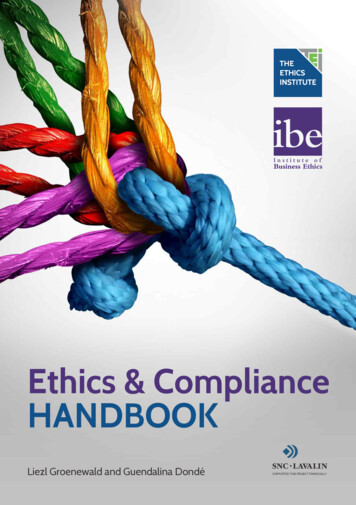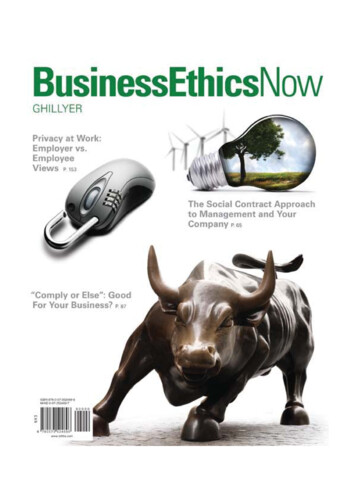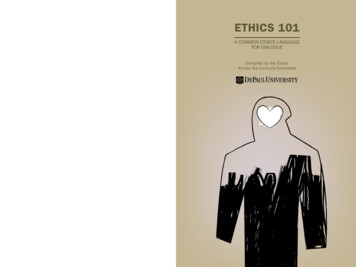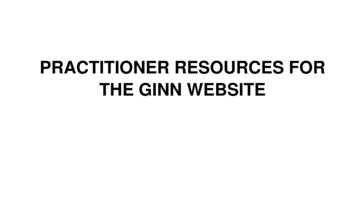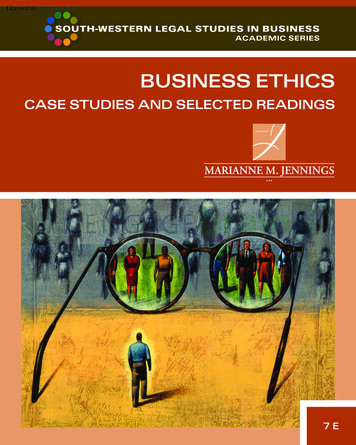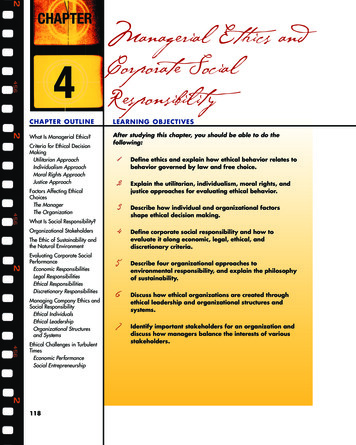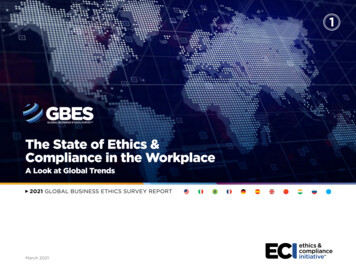
Transcription
1The State of Ethics &Compliance in the WorkplaceA Look at Global Trends2021 GLOBAL BUSINESS ETHICS SURVEY REPORTMarch 2021
ABOUT THE ETHICS & COMPLIANCE INITIATIVEThe Ethics & Compliance Initiative (ECI ) has a mission to empower individuals and organizations to build and sustainhigh-quality ethics & compliance programs. Established in 1922, the organization comprises the two oldest nonprofits inthe ethics & compliance industry. As an association, ECI brings together ethics & compliance professionals and academicsfrom all over the world to share techniques, resources and exciting new ideas.Through its research, ECI identifies the practices that improve ethics & compliance program effectiveness and buildinstitutional culture strength. ECI also has an established track record of providing support to organizations seeking totransform their cultures, often in the wake of significant challenges with noncompliance.Contact InformationEthics & Compliance Initiative2650 Park Tower Drive, Suite 802Vienna, VA 22180Tel: 703.647.2185 FAX: 703.647.2180www.ethics.org research@ethics.orgFor additional copies of this report, permission and licensing contact ECI: 703-647-2185 or research@ethics.org.For media inquiries, contact Florence Sumaray, vice president, marketing & communications at Florence@ethics.org.All content contained in this report is for informational purposes only. ECI cannot accept responsibility for any errors oromissions or any liability resulting from the use or misuse of any information presented in this report. 2021 Ethics Research Center, the research arm of the Ethics & Compliance Initiative.ISBN: 978-1-7923-6391-7All rights reserved. Printed in the United States of America.
The State of Ethics & Compliance in the WorkplaceA Look at Global TrendsTable of ContentsAbout This Report.4Trend 4: More Employees Are Reporting Misconduct.19U.S. Trends.5U.S. Trends.19Global Trends.5Global Trends. 21A Refresher on Workplace Culture and Ethical Behavior.6Trend 5: Retaliation Rates Have Skyrocketed. 22Executive Summary.8U.S. Trends. 22U.S. Trends.8Global Trends. 23Global Trends.10Special Section: COVID-19 and the Impact on Employees—Global. 24Trend 1: Ethical Culture Strength Remains High. 11U.S. Trends. 11Global Trends. 12Trend 2: Pressure to Compromise Standards Is theOrganizational Changes During the COVID-19 Pandemicand Impact on Ethics Outcomes . 25Conclusions. 27Recommendations. 28Highest It Has Ever Been. 13Methodology. 29U.S. Trends. 13Our Funders. 31Global Trends. 15About GBES. 32Trend 3: Observed Misconduct—While Steady—Is Inching Upwards.16U.S. Trends.16Global Trends. 183THE STATE OF ETHICS & COMPLIANCE IN THE WORKPLACE: A LOOK AT GLOBAL TRENDS 2021 Ethics Research Center, the research arm of the Ethics & Compliance Initiative
About This ReportSince 1994, the Ethics & Compliance Initiative (ECI) has conducteda longitudinal, cross-sectional study of workplace conduct from theemployee’s perspective.1 Now in its sixteenth iteration, ECI’s Global BusinessEthics Survey (GBES ) data provide the global benchmark on the state ofStrong EthicsCultureethics & compliance (E&C) in business.2DecreasedOrganizationalRisk of E&CViolationsReportingSince its inception, ECI’s research has provided leaders with reliable dataon trends in workplace ethics focusing on the key drivers that improveethical cultures in the workplace and how changes in culture impact ethicsoutcomes. The strength of an organization’s ethics culture is measuredthrough multiple indicators of employee behaviors at various levels within anorganization, including leaders, supervisors and coworkers. These behaviorsdemonstrate and promote a commitment to ethics on a daily basis. A thrivingHIGH-QUALITY E&C PROGRAM ethics culture involves commitment, modeling and the right conduct by allemployees in an organization. Our research shows that the quality of anorganization’s E&C program and the strength of the organization’s ethicsculture is key to achieving desired ethics outcomes.PressureObserved MisconductIn addition, while a multitude of factors influence ethical behavior, theinterplay of four major ethics outcomes are tied to the daily micro decisionsRetaliationemployees make with respect to how they behave in the workplace. Theseare: pressure in the workplace to compromise ethical standards; observationsof misconduct; reporting misconduct; and ultimately, the retaliation perceivedby employees after they reported misconduct.Historically, ECI reported findings from the research under two titles: the National Business Ethics Survey (NBES ), which provided measures of U.S. workplaces, and the Global Business Ethics Survey, whichexpanded the study to include workplaces globally. In 2017, ECI updated both the U.S. and global measures,now under a single banner as the Global Business Ethics Survey. The NBES and GBES have historicallybeen fielded by the Ethics Resource Center (ERC). After a strategic alliance, ERC is now branded under theEthics & Compliance Initiative (ECI).12The NBES was administered in the U.S. only in 1994, 2000, 2003, 2005, 2007, 2009, 2011 (two times), 2012(two times), 2013, 2015 and 2017, including subject-specific NBESs. The GBES was administered in countriesoutside of the U.S. in 2016 and 2019 were limited to 1,000 respondents (versus 5,000) and, thus, are notincluded in this report. Global results are presented for the following years: 2015, 2019 and 2020 (forcomparability of the countries surveyed).“The strength of an organization’s ethics culture ismeasured through multiple indicators of employeebehaviors at various levels within an organization,including leaders, supervisors and coworkers.”4THE STATE OF ETHICS & COMPLIANCE IN THE WORKPLACE: A LOOK AT GLOBAL TRENDS 2021 Ethics Research Center, the research arm of the Ethics & Compliance Initiative
U.S. TRENDSIn this report, GBES data collected from employees in 10 countries fromAugust to September 2020 are summarized and compared with previousdata. ECI has been tracking and reporting on the four ethics outcomes in the United States for20 years. The 20-year U.S. trends are the primary focus in this report to provide a historic viewof ECI’s research.As GBES is a longitudinal research study, most of the questions included in the 2020 datacollection remained the same or similar to previous iterations. However, new questions havebeen added over time and the way in which questions are asked have evolved across iterations.Relevant modifications are noted throughout the report.GLOBAL TRENDSIn 2015, data collection was expanded to countries outside of the U.S. Globaltrend data were examined for three years—2015, 2019 and 2020—for ninecountries: Brazil, China, France, Germany, India, Mexico, Russia, Spain andthe United Kingdom. Throughout this report, the 2020 global median (of all 10 countries) isdepicted in graphs to provide a barometer of the global outlook. Global data are also discussedto provide context, though the trends cover a period of five years—from 2015 to 2020.“The 20-year U.S. trends are the primary focus in this report toprovide a historic view of ECI’s research. Global trends that covera period of five years are also discussed.”SPECIAL CONSIDERATIONSIt is important to mention that the 2020 GBES data collection occurred during the COVID-19pandemic, which has had a significant impact on workplaces and employees across the globe.COVID-19 has led to employees working and organizations operating differently alongside abackdrop of upheaval in global and local economies. Within the context of these unusual times,it is not unexpected that employee perceptions of their workplaces and the behaviors that takeplace within the workplace have been impacted by circumstances that are far from “regularbusiness operations.” Many of the GBES questions ask employees to base their observationson the past 12 months. This means that respondents were answering questions about theirorganizations within the context of the COVID-19 pandemic. While in some countries the periodof impact has been longer than in others, workplaces were grappling with the pandemic duringa large portion of the 12 months in which employees were asked about in the survey. To addressthis further, additional COVID-19-specific questions were added to the 2020 GBES to measurehow employees have been impacted by the pandemic. These findings are reported in a separatesection of the report.5THE STATE OF ETHICS & COMPLIANCE IN THE WORKPLACE: A LOOK AT GLOBAL TRENDS 2021 Ethics Research Center, the research arm of the Ethics & Compliance Initiative
A Refresher on Workplace Culture and Ethical BehaviorIn 2016, ECI convened an independent blue-ribbon panel of former enforcementIn short, when these conditions occur, organizations with HQPs and a strongofficials and E&C practitioners and academics, and challenged the group toethics culture have decreased risk for E&C violations.identify the traits that are common to “gold standard” E&C programs. Theconclusions of the group were published in the report titled Principles andResults presented in this report provide an overview of the average strength ofPractices of High-Quality Ethics & Compliance Programs. As part of our 2018organizations’ ethical cultures, which significantly influences workplace conduct.GBES research, ECI explored the impact of E&C program quality on employeeWhen the strength of an organization’s ethics culture is weak, the listed outcomesperceptions and behavior. Specifically, we asked U.S. employees about thesuffer. ECI’s research has consistently demonstrated that when employeespresence of E&C program practices in their workplace. We also inquired about theexperience pressure to compromise their organization’s workplace ethicslevel of quality of those efforts, based on a framework developed by the blue-standards, there are higher incidences of misconduct, lower reporting of the sameribbon panel. Finally, we examined the impact of E&C programs based on theirand higher rates of retaliation. In addition, when organizations are committed tolevel of maturity, and on employees’ perceptions and behavior.ethical leadership, shared values and building an ethics-focused business culture,4the organizations are more likely to have strong ethics health.5Two primary findings emerged that build the case for continually improving E&Cpractices and policies:1) The stronger the culture, the greater the impact: Eighty-four percent ofemployees working for organizations with an E&C program performing atthe “optimizing” level perceived their organization as having a strong ethicsculture, compared with just 13% of employees working for organizations withan “underdeveloped” E&C program.32) The higher the program quality, the stronger the ethics culture: Eighty-fivepercent of employees working for organizations with a strong ethics cultureindicated observing favorable outcomes, compared with 0% of employeesworking for organizations with a weak ethics culture.”ECI research has also shown that organizations with high-quality E&C programs(HQPs) are not only more likely to have strong ethics cultures, they also have animpact on the four major ethics outcomes in the following ways: Less pressure to compromise ethics standards; Less observed misconduct;“In 2000, only 10% of U.S. employees worked in anenvironment with a strong ethical culture (21% in 2020).In addition, only 56% of employees reported misconductthey observed in 2000 (86% in 2020).” More reporting of misconduct observed; and, Less retaliation for reporting.3Results based on the 2018 GBES.4Improving Ethical Outcomes: The Role of Ethics Training (Ethics Research Center, 2008).Reducing Perceived Pressure to Behave Unethically: The Role of Leaders and Coworkers(Ethics Research Center, 2008).56THE STATE OF ETHICS & COMPLIANCE IN THE WORKPLACE: A LOOK AT GLOBAL TRENDS 2021 Ethics Research Center, the research arm of the Ethics & Compliance Initiative
A Refresher on Workplace Culture and Ethical BehaviorAs the culture strengthens, employee conduct improves. Organizations withstrong cultures are 467% more likely to demonstrate a positive impact on employeesthan organizations with weak-leaning cultures. This impact includes employees’recongnizing and adhering to organizational values, feeling prepared to handle keyrisks, reporting suspected wrongdoing, and reduced levels of misconduct overall.84%79%34%28%13%Underdeveloped% Employees ObservingFavorable OutcomesThe Higher the Program Quality, the Stronger the CultureOrganizations with high-quality programs (shown here as optimizing)demonstrate a 546% increase in culture strength over organizations at thelowest level of program quality.% with Strong CulturesThe Higher the Program Quality, the Stronger the Culture85%66%15%0%DefiningAdaptingManagingLevel of Program ongStrength of Organizational Culture7THE STATE OF ETHICS & COMPLIANCE IN THE WORKPLACE: A LOOK AT GLOBAL TRENDS 2021 Ethics Research Center, the research arm of the Ethics & Compliance Initiative
Executive SummaryU.S. Trends: The Ethics Landscape (2000-2020)NOTE ON U.S. AND GLOBAL DATA:To compare findings across survey years, U.S. data in this report were based onresponses from employees working in for-profit organizations. Global data werebased on responses from employees working in the for-profit, nonprofit andgovernmental sectors. For a more detailed explanation of the methodology, sed onSpecific ObservedMisconductIndex)s21%s30%s49%please see the “Methodology” section.U.S.U.S. TRENDSAmid the COVID-19 pandemic, ECI’s 2020 GBES revealed a yearREPORTING(Based on s79%Source: The State of Ethics & Compliance in the Workplace: A Look at Global Trends (ECI, 2021)of extremes. The promising news is that culture strength is at oneof its highest points in the 20-year look at U.S. data, and employees continued toreport misconduct they had observed at very high rates. Despite the turbulence of Based on ECI’s previous research, we know that when there is increasedthe pandemic, culture strength and rates of reporting misconduct remained intactpressure, the rate of observed misconduct also increases. This pattern held foror improved:2020, although the rate of observed misconduct in the United States increased Slightly more than one in five U.S. employees (21%) were in workplaces with astrong ethical culture, mirroring ECI’s finding in 2017.only slightly since 2017 and remains steady in relation to the 20-year trend. Employee perceptions that they experienced retaliation after reporting Continuing a positive trend that began after 2013, employees who observedmisconduct is also the highest it has ever been in the United States and hasmisconduct in 2020 were more likely to report their observation than theynearly doubled since 2017.were in 2017 (86% vs. 69%).These findings reveal that the E&C profession in the United States continuesto make substantial progress by instilling elements that encourage ethicalNOTES ON U.S. DATA The Specific Observed Misconduct Index consists of 16 types of misconductbehavior and promote ethical culture in the workplace. A strong ethical culturethat have been asked about in each survey year since 2000. The rate ofis characterized by accountability for wrongdoing, trust in and communicationobserved misconduct is based on the percentage of respondents whofrom leadership, and all employees setting a good example of ethical workplaceobserved at least one of the 16 types of misconduct.behavior. The percentages for reporting and retaliation are based on the generalHowever, despite these positive findings, there were also some troubling indicators: Employees were more likely to feel pressure to compromise theirobserved misconduct question. This is to allow for year-over-year comparisonsbeginning in 2000.organization’s ethics standards (e.g., to “bend the rules”) during periods .6of organizational change. In 2020, employee pressure was at the highest .it has been in the United States since 2000, and it had more than doubledsince 2017.6Will the COVID-19 Pandemic Increase Pressure for Employees to Bend the Rules? (EthicsStat, 2020)“”Based on ECI’s previous research, we know that when there is increasedpressure, the rate of observed misconduct also increases.8THE STATE OF ETHICS & COMPLIANCE IN THE WORKPLACE: A LOOK AT GLOBAL TRENDS 2021 Ethics Research Center, the research arm of the Ethics & Compliance Initiative
Management Level—U.S.7Management Level—U.S. (2020)When analyzing the data, ECI found that an employee’s level within theirorganization was associated with employee’s perspectives across all five 7%12%34%64%45%contributors were particularly pronounced.ethics culture. Top managers were more likely to say they worked in strongREPORTING(Based onSpecific ObservedMisconductIndex)the key indicators. The differences between top managers and individualThese findings revealed a mixed picture regarding management level andOBSERVEDMISCONDUCTSTRONGETHICALCULTURE(Based on cal cultures, but they were also more likely to say they experiencedpressure, observed misconduct and experienced retaliation. Some of thismay be due to top managers’ tendencies to ignore issues and evaluatethemselves, their coworkers and their peers more favorably than may bewarranted. However, other factors are likely at play, and those are explored inSource: The State of Ethics & Compliance in the Workplace: A Look at Global Trends (ECI, 2021)more detail throughout this report.Ethics & Compliance Program EffectivenessECI also examined the extent to which management level was associatedwith E&C program effectiveness.8 The data showed that employees workingin management positions were much more likely to indicate they workedin organizations with effective programs. However, rates of programeffectiveness are still far behind where they need to be. Only slightly morethan one-half (55%) of top-management employees indicated working inan organization with an effective E&C program, and fewer than one in four(23%) non-management employees indicated the same.“Culture strength in the U.S. is at one of its highest pointsin 20 years, yet more can be done, and little progresshas been made since 2017 to implement one of themost important strategies to mitigate wrongdoing.”Management-level data are based on GBES U.S. data from 2020 or 2017. Unless noted, allmanagement-level data is based on GBES U.S. data from 2020.7ECI measures program effectiveness through a series of questions about program elements andthe extent to which employees feel comfortable raising concerns.89THE STATE OF ETHICS & COMPLIANCE IN THE WORKPLACE: A LOOK AT GLOBAL TRENDS 2021 Ethics Research Center, the research arm of the Ethics & Compliance Initiative
GLOBAL TRENDSGlobal Trends: The Ethics Landscape (2015 to 2020)Overall, the global trends largely mirrored those of the U.S. trends.OBSERVEDMISCONDUCTThe most promising news is that reporting is at one of its highestpoints since ECI began collecting global data in 2015. However,pressure to compromise standards and rates of retaliation are also at their highestPRESSURE(Based onGeneralMisconductQuestion)s29%s33%points since 2015. And following a decrease in 2019, observed misconduct is nowat the same level it was in 2015.GlobalMedianREPORTING(Based on s61% Employees in China were most likely to say they experienced pressure (53%),while employees in Russia were least likely to say the same (16%).Source: The State of Ethics & Compliance in the Workplace: A Look at Global Trends (ECI, 2021) Rates of observed misconduct are highest in China (46%) and lowest inGermany (20%). Employees in India were most likely to report the misconduct they observed(97%), and employees in Russia were least likely to say the same (64%). Rates of retaliation are highest in India (90%) and lowest in Russia (41%).NOTES ON GLOBAL DATA The “global median” refers to the median of all 10 countries surveyed in the2020 GBES. While U.S. data was included in the calculation of global mediandata, the U.S. data are not shown in charts comparing data at the countrylevel. U.S. data are displayed separately within U.S. Trends sections of .the report. In contrast to U.S. trend data, the rate of misconduct for global data is basedon one general question about observed misconduct. This is to allow for yearover-year comparisons beginning in 2015. Prior versions of the global surveydid not include questions about specific types of misconduct. Reporting and retaliation data were based on responses to the generalobserved misconduct question. This is to allow for year-over-yearcomparisons beginning in 2015.“”In contrast to U.S. trend data, the rate of misconduct for globaldata is based on one general question about observed misconduct.THE STATE OF ETHICS & COMPLIANCE IN THE WORKPLACE: A LOOK AT GLOBAL TRENDS10 2021 Ethics Research Center, the research arm of the Ethics & Compliance Initiative
Trend 1 Ethical Culture Strength Remains HighHigher-quality E&C programs are linked with stronger cultures.The single most significant influence on employee conduct isculture. In strong cultures, wrongdoing is significantly reduced.Culture StrengthCultureStrength Index—U.S.Index—U.S.Percentage of Employees Experiencing Strong Ethical Cultures24%U.S. TRENDS21%Based on ECI’s Culture Strength Index,9 more thanone in five U.S. employees (21%) indicated that their18%21%21%16%organization has such an environment. While culture strength is amongthe highest it has been since 2000, it remained mostly unchanged overthe past decade (and since 2017). Given that culture is the most influential20%10%14%12%determinant of employee conduct,10 more work needs to be done to20Top managers have consistently had more favorable views of theirorganizations’ ethical culture than all other employees. This pattern held inM Glo 20ed bia aln20202017201320112009200720052003Management Level and Culture Strength—U.S.2000improve culture strength, especially during these challenging times.Source: The State of Ethics & Compliance in the Workplace: A Look at Global Trends (ECI, 2021)2020; however, the gap between top management and non-managementemployees decreased to its smallest point since 2011. Between 2013 and2020, the percentage of top management employees who experienced astrong culture decreased by 11 percentage points while there was only aCulture StrengthStrength ement Level—U.S.Percentage of Employees Experiencing Strong Ethical Culturesone percentage point decrease among non-management employees.100%The weakening of a perceived ethical culture (in their organization) amongtop management is mirrored by increases in three key ethics outcomes—pressure, misconduct and retaliation—and these three areas will beexplored in more detail throughout this report.80%60%40%10See “A Refresher on Workplace Culture” on page 7.Top managementMiddle managementFirst-line supervisor2020201720132011Employee perceptions are grouped together to form ECI’s Culture Strength Index. Survey itemsthat make up the index include the following: (1) accountability of top management, supervisorsand non-management employees; (2) satisfaction with information from top management andsupervisors about what is going on in the organization; (3) trust that top management andsupervisors will keep their promises and commitments; and (4) top management, supervisors andcoworkers set a good example of ethical workplace behavior.9200920%Non-managementSource: The State of Ethics & Compliance in the Workplace: A Look at Global Trends (ECI, 2021)11THE STATE OF ETHICS & COMPLIANCE IN THE WORKPLACE: A LOOK AT GLOBAL TRENDS 2021 Ethics Research Center, the research arm of the Ethics & Compliance Initiative
GLOBAL TRENDSCulture Strength Index—GlobalRegardless of the country, most employees did not workPercentage of Employees Experiencing Strong Ethical Culturesin organizations with strong ethical cultures. The globalmedian for strong cultures was 14%. Employees from Indiawere the most likely to perceive working in a strong ethics culture (28%);23%28%25%employees from France were the least likely (8%).13%14%14%11%GM loed baia xico“”Regardless of the country, most employees did not workin organizations with strong ethical cultures.8%13%Source: The State of Ethics & Compliance in the Workplace: A Look at Global Trends (ECI, 2021)12THE STATE OF ETHICS & COMPLIANCE IN THE WORKPLACE: A LOOK AT GLOBAL TRENDS 2021 Ethics Research Center, the research arm of the Ethics & Compliance Initiative
Trend 2 Pressure to Compromise Standards Is the Highest It Has Ever BeenPressure to compromise standards serves as a warning signal forboth ongoing and future misconduct. Employees working in highpressure organizations are much more likely to observe misconductin their workplace.Percentage of Employees Experiencing Pressure—U.S.30%29%U.S. TRENDSIn 2020, 30% of U.S. employees agreed that they experienced10%8%13%13%20132005has consistently increased over the last decade. Some of the double-digit200911%200711%2003percentage point increase since 2017.11 This is part of an ongoing trend; pressure201116%14%pressure to compromise their organization’s workplace ethics standards, a 14increase in pressure between 2017 and 2020 was likely due to the COVID-1920M Glo 20ed bia alnpressure compared with the time before the COVID-19 pandemic.2020In the U.S., 44% of employees said they were experiencing more work-related20172000pandemic (See Special Section: COVID-19 and the Impact on Employees).Source: The State of Ethics & Compliance in the Workplace: A Look at Global Trends (ECI, 2021)Management Level and Pressure to CompromiseStandards—U.S.Historically, ECI research has shown that top management and middlePercentage of Employees Experiencing Pressure—Management Level—U.S.management have experienced more pressure than first-line supervisors ornon-management employees. Results from the 2020 GBES reveal a similarrelationship between management level and pressure; however, the differencebetween non-management and top-management is much more pronounced.In 2020, 12% of non-management employees said they experienced pressureto compromise standards, while 51% of top managers and 63% of middle100%80%60%managers said the same.40%One reason for the shift in 2020 appears to be the increase in organizationaltransitions that are taking place, largely due to COVID-19 and its economic20%Top managementResponse options changed from “Yes” and “No” in 2017 to an agreement scale (“Strongly agree”to “Strongly disagree”) in 2020. The percentage of employees who indicated “Strongly agree” or“Agree” in 2020 were combined and compared with the percentage of employees who indicated“Yes” in 2017.Middle managementFirst-line supervisor20202017201320112009impact. Research by ECI has shown that organizational change adverselyNon-managemen
The Ethics & Compliance Initiative (ECI ) has a mission to empower individuals and organizations to build and sustain high-quality ethics & compliance programs. Established in 1922, the organization comprises the two oldest nonprofits in the ethics & compliance industry. As an association, ECI brings together ethics & compliance .



